Hypolimnas bolina
Hypolimnas bolina, the great eggfly,[1][2] common eggfly[2] or in New Zealand the blue moon butterfly[3] is a species of nymphalid butterfly found from Madagascar to Asia[1] and Australia.[2]
| Great eggfly | |
|---|---|
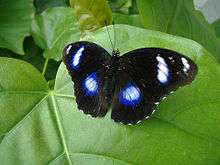 | |
| Male | |
 | |
| Female | |
| Scientific classification | |
| Kingdom: | Animalia |
| Phylum: | Arthropoda |
| Class: | Insecta |
| Order: | Lepidoptera |
| Family: | Nymphalidae |
| Genus: | Hypolimnas |
| Species: | H. bolina |
| Binomial name | |
| Hypolimnas bolina | |
| Subspecies | |
|
Eight, see text | |
| Synonyms | |
| |
Appearance
Race bolina
H. bolina is a black-bodied butterfly with a wingspan of about 70–85 millimetres (2.8–3.3 in). The species has a high degree of sexual dimorphism. The female is mimetic with multiple morphs.[4]
Male
The upperside of the wings is jet black, offset with three pairs of white spots, two on the forewing and one on the hindwing. These spots are surrounded by purple iridescence. In addition, the upperside of the hindwing bears a series of small white dots.[5][6]
Female
The upperside of the wings of the female is a brownish black and does not have any spots like those of the male. The edges bear white markings which are similar to those of the common Indian crow.[5]
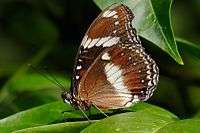 Female, underside
Female, underside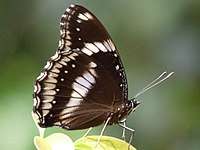 Male, underside
Male, underside Eggs
Eggs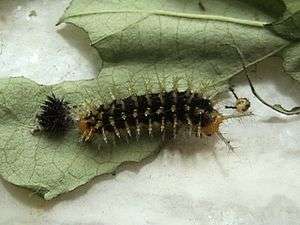 Caterpillar of race bolina
Caterpillar of race bolina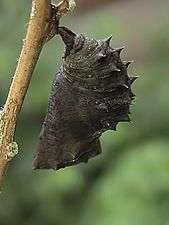 Pupa of race bolina
Pupa of race bolina
Distribution
_great_eggfly_butterfly_at_Madhurawada_01.jpg)
H. bolina is found in Madagascar in the west, through to South and Southeast Asia, Cambodia, the South Pacific islands (French Polynesia, Tonga, Tuvalu, Samoa and Vanuatu), and occurs in parts of Australia, Japan, and New Zealand.[2]
Habitat
H. bolina is a fairly common butterfly found in lightly wooded country, deciduous forests, thick and moist scrub, and the greener parts of human habitats.
Mimicry
To the west the female is monomorphic, mimicking species of the oriental and Australasian danaid genus Euploea. Eastwards H. bolina is frequently polymorphic and most forms are then non-mimetic. In areas where it resembles Euploea the butterfly has usually been designated a Batesian mimic.
Life cycle and ecology
H. bolina is known for maternal care, with the females guarding leaves where eggs have been laid. Males are also very territorial and site fidelity increases with age.[7] Territories that enhance the detection of females are preferred.[8] The female hovers over a plant to check for ants which will eat her eggs. After selecting a plant which has no ants on it, she lays at least one but often two to five eggs on the undersides of the leaves.
Host plants
Race bolina breeds on Sida rhombifolia,[9] Elatostemma cuneatum, Portulaca oleracea, Laportea interrupta,[10] Triumfetta pentandra,[11] and Asystasia species.
Other hosts include Elatostema cuneatum, Fleurya interrupta, Pseuderanthemum variabile, and Synedrella nodiflora. They are also known to feed on Urtica dioica and Malva species.
Eggs
The eggs are a pale, glassy green with longitudinal ridges except on the top.
Caterpillar
After about four days the eggs hatch. The caterpillars immediately disperse. They are black with an orange head. The last segment is also orange. The head bears a pair of long branched black horns. The body surface is also covered with long, branched, orangish black spines. These spines look whitish and transparent immediately after moulting, but soon become the usual orange. In later instars the spiracles are surrounded by thin, dirty orange rings. Infection by Wolbachia bacteria is known to exclusively kill male specimens.[3][12]
Pupa
The pupa is suspended by just one point. It is brown with a grey tinge on the wings. The abdominal segments have distinct tubercles. The surface of the pupa is rough. The butterfly emerges after seven to eight days as pupae (female development is always a bit longer).
Recent evolutionary changes
On the Samoan Islands of Upolu and Savai'i, a parasite (probably Wolbachia) had been killing the male members of Hypolimnas bolina. The problem was so severe that by 2001, males made up only 1% of the population. However, in 2007, it was reported that within a span of just 10 generations (about 5 years), the males had evolved to develop immunity to the parasite, and the male population increased to nearly 40%.[13]. This evolutionary event involved changes at a single genomic region on chromosome 25 [14][15], and represents one of the fastest examples of natural selection observed to date in natural populations. Ed Yong has written a popular science account of this highly unusual evolutionary event [16].
Subspecies
Listed alphabetically:[2]
- H. b. bolina (Linnaeus, 1758) – (Sumatra, Java, Lesser Sunda Islands, western Borneo, Sulawesi, Salayar, Kabaena, Galla, Banggai, Sula, Maluku, New Guinea, Solomon Islands, Australia, New Caledonia)
- H. b. constans (Butler, 1875) – (Tasmania?)
- H. b. enganica Fruhstorfer, 1904 – (Engano Island)
- H. b. gigas (Oberthür, 1879) – (Sangihe)
- H. b. incommoda Butler, 1879
- H. b. inconstans Butler, 1873 – (Navigator Islands)
- H. b. jacintha (Drury, 1773)
- H. b. jaluita Fruhstorfer, 1903
- H. b. kezia (Butler) – (Formosa)
- H. b. kraimoku (Eschscholtz, 1821) – (Lifu)
- H. b. labuana Butler, 1879 – (Labuan)
- H. b. lisianassa (Cramer, 1779) – (Moluccas)
- H. b. listeri Butler, 1888 – (Christmas Island)
- H. b. montrouzieri (Butler) – (Woodlark, Fergusson, Trobriand Islands)
- H. b. naresii Butler, 1883 – (Fiji)
- H. b. nerina (Fabricius, 1775) – (Timor - Kai, Aru, Waigeu, West Irian - Papua, northern Australia - eastern Victoria, Bismarck Archipelago, Solomon Islands, New Zealand)
- H. b. pallescens (Butler) – (Fiji)
- H. b. philippensis (Butler, 1874) – (Philippines)
- H. b. pulchra (Butler) – (New Caledonia)
- H. b. rarik Eschscholtz, 1821) – (Lifu)
References
- R.K., Varshney; Smetacek, Peter (2015). A Synoptic Catalogue of the Butterflies of India. New Delhi: Butterfly Research Centre, Bhimtal & Indinov Publishing, New Delhi. p. 206. doi:10.13140/RG.2.1.3966.2164. ISBN 978-81-929826-4-9.
- Archived 2018-04-29 at the Wayback Machine "Hypolimnas Hübner, [1819]" at Markku Savela's Lepidoptera and Some Other Life Forms
- Liza Gross (2006). "Conflict within the genome: evolving defenses to suppress the male killers". PLoS Biology. 4 (9): e308. doi:10.1371/journal.pbio.0040308. PMC 1551929. PMID 20076639.
- Cyril Clarke; P. M. Sheppard (1975). "The genetics of the mimetic butterfly Hypolimnas bolina (L.)". Philosophical Transactions of the Royal Society of London. Series B, Biological Sciences. 272 (917): 229–265. doi:10.1098/rstb.1975.0084. JSTOR 2417483. PMID 4830.
-

-

- Darrell J. Kemp (2001). "Age-related site fidelity in the territorial butterfly Hypolimnas bolina (L.) (Lepidoptera: Nymphalidae)". Australian Journal of Entomology. 40 (1): 65–68. doi:10.1046/j.1440-6055.2001.00199.x.
- Darrell J. Kemp; Ronald L. Rutowski (2001). "Spatial and temporal patterns of territorial mate locating behaviour in Hypolimnas bolina (L.) (Lepidoptera: Nymphalidae)" (PDF). Journal of Natural History. 35 (9): 1399–1411. doi:10.1080/002229301750384329.
- K. Kunte (2006). "Additions to the known larval host plants of Indian butterflies". Journal of the Bombay Natural History Society. 103 (1): 119–121.
- T. R. Bell (1910). "Common Butterflies of the Plains of India". Journal of the Bombay Natural History Society. 20 (2): 287–289.
- A. Rajagopalan (2005). "A new food plant of the Great Eggfly". Journal of the Bombay Natural History Society. 102 (3): 355.
- E. A. Dyson; M. K. Kamath; G. D. Hurst (2002). "Wolbachia infection associated with all-female broods in Hypolimnas bolina (Lepidoptera: Nymphalidae): evidence for horizontal transmission of a butterfly male killer". Heredity. 88 (3): 166–171. doi:10.1038/sj.hdy.6800021.
- Sylvain Charlat; Emily A. Hornett; James H. Fullard; Neil Davies; George K. Roderick; Nina Wedell; Gregory D. D. Hurst (2007). "Extraordinary flux in sex ratio". Science. 317 (5835): 214. doi:10.1126/science.1143369. PMID 17626876.
- Hornett, E.A. et al The Evolution of Sex Ratio Distorter Suppression Affects a 25 cM Genomic Region in the Butterfly Hypolimnas bolina (2014) https://doi.org/10.1371/journal.pgen.1004822
- Reynodls, L.A. et al. Suppression of Wolbachia-mediated male-killing in the butterfly Hypolimnas bolina involves a single genomic region (2019) https://doi.org/10.7717/peerj.7677
- Yong, E. The Strange Case of the Butterfly and the Male-Murdering Microbe (2016) https://www.theatlantic.com/science/archive/2016/08/the-strange-case-of-the-butterfly-and-the-male-killer/496637/
| Wikimedia Commons has media related to Hypolimnas bolina. |
| Wikispecies has information related to Hypolimnas bolina |
External links
- Evolution of Male-Killer Suppression in a Natural Population
- Butterflycorner.net (English/German)
- Hypolimnas bolina at CalPhotos